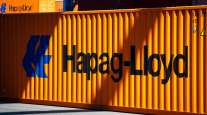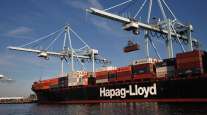Financing Hitches Could Delay Hapag-Lloyd-UASC Shipping Merger

A merger of German container shipping line Hapag-Lloyd and United Arab Shipping Co. likely will take months to complete, partly due to financing issues blamed on a deep industry downturn, sources familiar with the deal say.
Hapag-Lloyd signed a binding agreement with UASC in July to form the world's fifth-largest line, valued at about 7 billion to 8 billion euros ($7.2 billion-$8.3 billion), by the end of 2016.
But three sources told Reuters that timeline is being held up, partly because some banks want to pull out of loans, particularly to UASC, due to the sector crisis. One source said the sum totaled at least $500 million and could be as much as $900 million.
Global container shipping is suffering its worst downturn, caused by a faltering global economy and too many ships. The slump has prompted a series of mergers and alliances designed to save costs and pool ships and routes. The tough conditions also have led many banks to cut lending to the industry.
Two of the sources said the syndicate banks required a cash injection from UASC shareholders. Kuwait-headquartered UASC declined to comment when contacted.
The sources said Qatar Investment Authority, one of the world's largest sovereign wealth funds, could step in to cover the financing gap via a loan. One source said this could be provided by Qatar National Bank.
QIA and QNB declined to comment.
Hapag-Lloyd said in a statement: "We are in the middle of getting all necessary approvals for our merger from the lending banks of the companies. This is a normal process before one can close such a transaction.
"If more banks are involved, this process takes longer. It runs parallel to the approval process with the competition authorities, which is close to the finish line."
One of the sources said completion could be pushed back until the end of the first quarter of 2017. "The deal is slower than hoped for, but there is no sense of it falling through," the source added.
The combined company would enable Hapag-Lloyd to gain access to bigger ships on the major Asia-to-Europe trade route and give UASC wider access to routes that the German line is strong on.
UASC, founded in 1976 and with corporate offices in Dubai, is owned by the governments of the United Arab Emirates, Bahrain, Saudi Arabia, Kuwait, Qatar and Iraq. Qatar holds a 51% stake in the group, Saudi Arabia has 35% and the remaining nations the rest.
The sources said another complication is the planned sale of shipping company United Arab Chemical Carriers (UACC). UASC is the biggest shareholder in UACC, data from UASC's and UACC's websites show.
The first source said that UACC, founded in 2007 and with a fleet of chemical and oil products tankers, was valued at over $150 million.
"UACC as a special item is pending, but it is not a deal breaker," a second source said.
A third source said all sides were trying to resolve the hold-ups.
The European Commission said last month it had given its conditional approval for the merger subject to UASC withdrawing from certain vessel-sharing agreements on trade routes between northern Europe and North America.
Hapag Lloyd said in August the merger would give it "net synergies of at least $400 million, some of which should already take effect next year." Its shareholders approved a capital increase to fund the merger.
In 2013, a planned merger between Hapag-Lloyd and Hamburg Sud was called off as terms could not be reached.
(Additional reporting by Jan Schwartz in Hamburg, David French in Dubai and Tom Finn in Doha)




